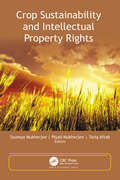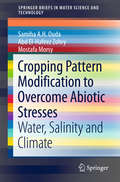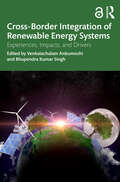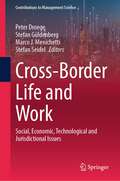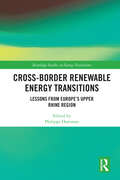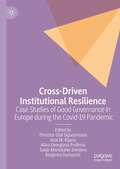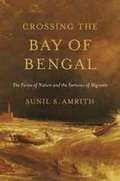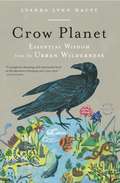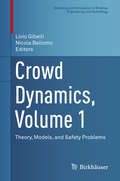- Table View
- List View
Crop Responses to Global Warming
by Dinesh Chandra Uprety V.R ReddyThe monograph entitled “Crop responses to Global warming” describes the normal historical shifts in the earth’s atmospheric temperature and weighs the evidence concerning anthropogenic induced changes in the level of temperature. The unprecedented increase in the earth’s temperature after pre industrial period has been possibly related to the anthropogenic activities. This monograph will give an overview of the global as well as Indian crops productivity in relation to the rise in the earth’s surface temperature. A chapter in this monograph is on the technologies to study the response of crop plants to the elevated temperature. The impact assessment analysis of rising temperature on crops such as wheat, rice, maize, soybean, cotton and brassica are described, reviewed and discussed in separate chapters as case studies. The responses of physiological processes and biochemical reactions to the elevated temperature in crop plants are described crop wise. The monograph also includes the impact of elevating temperature on crop weed interaction, pest and diseases and soil dynamics for each crop species independently. The mitigation technologies to counter the adverse effect of high temperature stress are described for each crop according to their cultivation and climatic conditions. The future research strategies for each crop to meet the threat of elevating temperature on crop productivity and food security is described and discussed. The description of temperature enrichment technologies will help researchers and scientists to study the responses of biological materials to rising temperature. The monograph will be the main text for teaching climate change, global warming and environmental botany as no such book is currently available relating to the rising atmospheric temperature on crop plants. Therefore, the monograph will be highly useful for students of global climate change, environmental botany and agricultural sciences, scientists, researchers, farmers and policy makers
Crop Sustainability and Intellectual Property Rights
by Soumya Mukherjee Piyali Mukherjee Tariq AftabThis new book merges the concepts of traditional agriculture, crop sustainability, and intellectualproperty rights associated with plant protection and agricultural products. It discusses various strategies associated with crop tolerance to adverse environmental conditions and also highlights the role of agricultural intellectual property rights, along with the implications for plant patents, protection of farmers’ rights, and geographical indication in plant products, to provide a broader outlook toward strategies for sustainable agriculture and global food security associated with IPR. The chapters provide an overview of sustainable crop cultivation in traditional agriculture as well as with new biotechnological approaches. The volume explores several stress resilience strategies and issues for crops, considering how to mitigate the effect of increased carbon dioxide concentration, heavy metal pollution, over-salinized soils, and cold spells. It also discusses how to make desert farming more efficient; how to increase abiotic stress tolerance of crops with grafting, seed soaking/priming, soil amendment, and more. The chapters on agricultural intellectual property rights address IPR in conjunction with food security, the rights of farmers, legal applications and protection of plant patents, protection of traditional knowledge, international legal issues, and plant variety protection rights in agriculture and more.
Crop Sustainability and Intellectual Property Rights
by Soumya Mukherjee Piyali Mukherjee Tariq AftabThis new book merges the concepts of traditional agriculture, crop sustainability, and intellectualproperty rights associated with plant protection and agricultural products. It discusses various strategies associated with crop tolerance to adverse environmental conditions and also highlights the role of agricultural intellectual property rights, along with the implications for plant patents, protection of farmers’ rights, and geographical indication in plant products, to provide a broader outlook toward strategies for sustainable agriculture and global food security associated with IPR. The chapters provide an overview of sustainable crop cultivation in traditional agriculture as well as with new biotechnological approaches. The volume explores several stress resilience strategies and issues for crops, considering how to mitigate the effect of increased carbon dioxide concentration, heavy metal pollution, over-salinized soils, and cold spells. It also discusses how to make desert farming more efficient; how to increase abiotic stress tolerance of crops with grafting, seed soaking/priming, soil amendment, and more. The chapters on agricultural intellectual property rights address IPR in conjunction with food security, the rights of farmers, legal applications and protection of plant patents, protection of traditional knowledge, international legal issues, and plant variety protection rights in agriculture and more.
Crop Variety Trials: Data Management and Analysis
by Weikai YanVariety trials are an essential step in crop breeding and production. These trials are a significant investment in time and resources and inform numerous decisions from cultivar development to end-use. Crop Variety Trials: Methods and Analysis is a practical volume that provides valuable theoretical foundations as well as a guide to step-by-step implementation of effective trial methods and analysis in determining the best varieties and cultivars. Crop Variety Trials is divided into two sections. The first section provides the reader with a sound theoretical framework of variety evaluation and trial analysis. Chapters provide insights into the theories of quantitative genetics and principles of analyzing data. The second section of the book gives the reader with a practical step-by-step guide to accurately analyzing crop variety trial data. Combined these sections provide the reader with fuller understanding of the nature of variety trials, their objectives, and user-friendly database and statistical tools that will enable them to produce accurate analysis of data.
Crop Variety Trials: Data Management and Analysis
by Weikai YanVariety trials are an essential step in crop breeding and production. These trials are a significant investment in time and resources and inform numerous decisions from cultivar development to end-use. Crop Variety Trials: Methods and Analysis is a practical volume that provides valuable theoretical foundations as well as a guide to step-by-step implementation of effective trial methods and analysis in determining the best varieties and cultivars. Crop Variety Trials is divided into two sections. The first section provides the reader with a sound theoretical framework of variety evaluation and trial analysis. Chapters provide insights into the theories of quantitative genetics and principles of analyzing data. The second section of the book gives the reader with a practical step-by-step guide to accurately analyzing crop variety trial data. Combined these sections provide the reader with fuller understanding of the nature of variety trials, their objectives, and user-friendly database and statistical tools that will enable them to produce accurate analysis of data.
Crop Wild Relatives: A Manual of in situ Conservation
by Danny HunterCrop wild relatives (CWR) are plant species which are more or less closely related to crops. They are a vital resource by providing a pool of genetic variation that can be used in breeding new and better adapted varieties of crops that are resistant to stress, disease, drought and other factors. They will be increasingly important in allowing crops to adapt to the impacts of climate, thus safeguarding future agricultural production. Until recently, the main conservation strategy adopted for CWR has been ex situ - through the maintenance of samples as seed or vegetative material in various kinds of genebank or other facilities. Now the need to conserve CWR in their natural surroundings (in situ) is increasingly recognized. Recent research co-ordinated by Bioversity International has produced a wealth of information on good practices and lessons learned for their effective conservation. This book captures the important practical experiences of countries participating in this work and describes them for the wider conservation community. It includes case studies and examples from Armenia, Bolivia, Madagascar, Sri Lanka and Uzbekistan, which are important centres of diversity for crop wild relatives, and covers four geographical regions - the Caucasus, South America, Africa and the Asia-Pacific Region. It provides practical, relevant information and guidance for the scaling-up of actions targeting CWR conservation around the world.
Crop Wild Relatives: A Manual of in situ Conservation (Issues In Agricultural Biodiversity Ser.)
by Danny Hunter Vernon HeywoodCrop wild relatives (CWR) are plant species which are more or less closely related to crops. They are a vital resource by providing a pool of genetic variation that can be used in breeding new and better adapted varieties of crops that are resistant to stress, disease, drought and other factors. They will be increasingly important in allowing crops to adapt to the impacts of climate, thus safeguarding future agricultural production. Until recently, the main conservation strategy adopted for CWR has been ex situ - through the maintenance of samples as seed or vegetative material in various kinds of genebank or other facilities. Now the need to conserve CWR in their natural surroundings (in situ) is increasingly recognized. Recent research co-ordinated by Bioversity International has produced a wealth of information on good practices and lessons learned for their effective conservation. This book captures the important practical experiences of countries participating in this work and describes them for the wider conservation community. It includes case studies and examples from Armenia, Bolivia, Madagascar, Sri Lanka and Uzbekistan, which are important centres of diversity for crop wild relatives, and covers four geographical regions - the Caucasus, South America, Africa and the Asia-Pacific Region. It provides practical, relevant information and guidance for the scaling-up of actions targeting CWR conservation around the world.
The Cropland Crisis: Myth or Reality? (RFF Agriculture and Fisheries Set)
by Pierre CrossonThis book examines the factors affecting the demand for agricultural land in the United States and the costs of meeting increasing demand. Originally published in 1982
The Cropland Crisis: Myth or Reality? (RFF Agriculture and Fisheries Set)
by Pierre CrossonThis book examines the factors affecting the demand for agricultural land in the United States and the costs of meeting increasing demand. Originally published in 1982
Cropping Pattern Modification to Overcome Abiotic Stresses: Water, Salinity and Climate (SpringerBriefs in Water Science and Technology)
by Samiha A. Ouda Abd El-Hafeez Zohry Mostafa MorsyThis book provides state-of-the art analysis, never done before in Egypt, on agro-climatic zones level. This study deals with how the national cropping pattern can be modified to overcome abiotic stresses, such as water scarcity, induced salinity and climate change to reduce their negative effects on food production. To this end, different cropping patterns are suggested. This study can be a framework for other developing countries to be used in quantifying and filling the gap in their knowledge about practices that can help in increasing their food security through increasing food production. Furthermore, the study is useful for policy makers to help them in their future plans and policies.
Cross-Border Integration of Renewable Energy Systems: Experiences, Impacts, and Drivers
by Venkatachalam Anbumozhi and Bhupendra Kumar SinghCross-border energy trade and integration of renewable energy have become significant for countries and regions to meet demands, minimize costs, and foster socio-economic and climate stability in the dynamic and unstable energy market. This book explores different models of global energy trade between regions and their benefits and challenges with a special focus on India’s Northeast region. Countries in South and Southeast Asia are endowed with abundant renewable energy resources. This book examines the energy mix of the countries such as India, Myanmar, Thailand, Bangladesh, and Bhutan among others and their efforts to achieve more integrated markets and renewable energy integration in the region. It highlights the potential of Northeast India given its rich natural resources and strategic location to harness the potential cross-border energy trade with ASEAN countries. The volume provides analytical perspectives on drivers, constraints, opportunities and barriers, as well as measures that countries could take to address institutional, financial, policy, and governance issues to minimize the total costs of energy security and maximize the social-economic benefits for people in these regions. It identifies the necessary conditions – grid flexibility, policy, market, and regulatory solutions for clean energy trade – and contributes to growth of low-carbon development as well as policy making by focusing on renewable energy integration across borders. This volume will be of interest to students and researchers of energy and climate studies, environmental politics, trade, and economics and international relations. This book is freely available as a downloadable Open Access PDF at www.taylorfrancis.com under a Creative Commons (CC-BY-NC-ND) 4.0 license.
Cross-Border Integration of Renewable Energy Systems: Experiences, Impacts, and Drivers
Cross-border energy trade and integration of renewable energy have become significant for countries and regions to meet demands, minimize costs, and foster socio-economic and climate stability in the dynamic and unstable energy market. This book explores different models of global energy trade between regions and their benefits and challenges with a special focus on India’s Northeast region. Countries in South and Southeast Asia are endowed with abundant renewable energy resources. This book examines the energy mix of the countries such as India, Myanmar, Thailand, Bangladesh, and Bhutan among others and their efforts to achieve more integrated markets and renewable energy integration in the region. It highlights the potential of Northeast India given its rich natural resources and strategic location to harness the potential cross-border energy trade with ASEAN countries. The volume provides analytical perspectives on drivers, constraints, opportunities and barriers, as well as measures that countries could take to address institutional, financial, policy, and governance issues to minimize the total costs of energy security and maximize the social-economic benefits for people in these regions. It identifies the necessary conditions – grid flexibility, policy, market, and regulatory solutions for clean energy trade – and contributes to growth of low-carbon development as well as policy making by focusing on renewable energy integration across borders. This volume will be of interest to students and researchers of energy and climate studies, environmental politics, trade, and economics and international relations. This book is freely available as a downloadable Open Access PDF at www.taylorfrancis.com under a Creative Commons (CC-BY-NC-ND) 4.0 license.
Cross-Border Life and Work: Social, Economic, Technological and Jurisdictional Issues (Contributions to Management Science)
by Peter Droege Stefan Güldenberg Marco J. Menichetti Stefan SeidelThis book discusses the risks, challenges, and opportunities of cross-border work and life from a multidisciplinary and multilevel perspective, including (a) the individual, (b) the social and organizational, and (c) the regional levels, taking into consideration the diverse and multilayered social, economic, technological, and jurisdictional issues involved.Emerging public policies and advanced information technologies (IT) have created new opportunities for work and life that thrive in global value chains and markets. Life, in general, and work, in particular, are increasingly organized across borders of various kinds and are subject to rapid change. At the same time, life and work have been determined by 19th and 20th century infrastructures and technologies. As a consequence, new strategies and measures are required for both physical and virtual work and life spaces.
Cross-Border Renewable Energy Transitions: Lessons from Europe's Upper Rhine Region (Routledge Studies in Energy Transitions)
by Philippe HammanThis book explores the intrinsically multiscale issue of renewable energy transition from a local, national and transnational perspective, and provides insights into current developments in the Upper Rhine Region that can serve as an international model. Organised around the exploration of stakeholder issues, the volume first describes a framework for public action and modelling and then articulates a triple complementary focus from the viewpoint of law, economics and sociology. This multidisciplinary approach is anchored in the social sciences, but also explores the ways in which technological issues are increasingly debated in the implementation of the ecological transition. With a focus on the Upper Rhine Region of France, Germany and Switzerland, the contributions throughout analyse how concrete regional projects emerge, and whether they are carried out by local authorities, private energy groups, network associations or committed citizens. From this, it appears that real-world energy transition modes can be best understood as permanent transactional processes involving institutional regulations, economic levers and barriers and social interactions. This book will be of interest to advanced students and scholars focusing on renewable energy transition, stakeholder issues, environment and sustainability studies, as well as those who are interested in the methodological aspects of the social sciences, especially within the fields of sociology, law, economy, geography, political science, urbanism and planning.
Cross-Border Renewable Energy Transitions: Lessons from Europe's Upper Rhine Region (Routledge Studies in Energy Transitions)
by Philippe HammanThis book explores the intrinsically multiscale issue of renewable energy transition from a local, national and transnational perspective, and provides insights into current developments in the Upper Rhine Region that can serve as an international model. Organised around the exploration of stakeholder issues, the volume first describes a framework for public action and modelling and then articulates a triple complementary focus from the viewpoint of law, economics and sociology. This multidisciplinary approach is anchored in the social sciences, but also explores the ways in which technological issues are increasingly debated in the implementation of the ecological transition. With a focus on the Upper Rhine Region of France, Germany and Switzerland, the contributions throughout analyse how concrete regional projects emerge, and whether they are carried out by local authorities, private energy groups, network associations or committed citizens. From this, it appears that real-world energy transition modes can be best understood as permanent transactional processes involving institutional regulations, economic levers and barriers and social interactions. This book will be of interest to advanced students and scholars focusing on renewable energy transition, stakeholder issues, environment and sustainability studies, as well as those who are interested in the methodological aspects of the social sciences, especially within the fields of sociology, law, economy, geography, political science, urbanism and planning.
Cross-Border Tourism in Protected Areas: Potentials, Pitfalls and Perspectives (Geographies of Tourism and Global Change)
by Marius Mayer Wojciech Zbaraszewski Dariusz Pieńkowski Gabriel Gach Johanna GernertThis book discusses how tourism between neighboring countries like Poland and Germany is hindered despite the Schengen Treaty. Taking protected areas in north-eastern Germany and north-western Poland as exemplary cases, it analyses the phenomenon of socio-economic and cultural barriers for cross-border tourism. It also presents the results of a representative online survey in both countries, and discusses socio-economic and geographical research on border areas, nature tourism in protected areas, national stereotypes and prejudices. As one of the very few source market studies on protected area tourism, it is relevant for scholars and practitioners (protected area managers, tourism professionals) alike providing them with insights into the implications for future research and tourism practice.
Cross-Driven Institutional Resilience: Case Studies of Good Governance in Europe during the Covid-19 Pandemic
by Throstur Olaf Sigurjonsson José M. Ruano Alina Georgiana Profiroiu Saulė Mačiukaitė-Žvinienė Kosjenka DumančićThis book presents a series of studies on organizations across Europe, displaying new perspectives on institutional resilience of affected governance structures during crisis. Such an approach to governance studies not only aims to provide readers with conceptual and practical knowledge on crisis experience of organizations, but also to equip them with necessary cognitive tools to perform well in a similar crisis context in the future. The book highlights knowledge on institutional resilience and delivers an enduring resource for researchers and students on a time of unprecedented crisis. Cross-national/sectorial interdependences in Europe are multiplying, while institutional reaction and international collaboration mechanisms are falling behind. The studies presented here aim to shape a conceptual understanding of students, academics, and practitioners considering these contemporary challenges and opportunities. They provide a valuable resource in the field of governance, sustainability, crisis management, innovation, and leadership.
Cross section through a leaf (large print)
by RnibThis is a labelled cross section diagram showing some of the various parts and types of cell in a plant leaf and some of their functions. There is a locator dot shown, which will be at the top left of the page when the image is the correct way up. The labels are on the left of the page, pointing to the parts of the leaf in the diagram on the right.
Cross section through a leaf (UEB contracted)
by RnibThis is a labelled cross section diagram showing some of the various parts and types of cell in a plant leaf and some of their functions. There is a locator dot shown, which will be at the top left of the page when the image is the correct way up. The labels are on the left of the page, pointing to the parts of the leaf in the diagram on the right.
Cross section through a leaf (UEB uncontracted)
by RnibThis is a labelled cross section diagram showing some of the various parts and types of cell in a plant leaf and some of their functions. There is a locator dot shown, which will be at the top left of the page when the image is the correct way up. The labels are on the left of the page, pointing to the parts of the leaf in the diagram on the right.
Crossing the Bay of Bengal: The Furies Of Nature And The Fortunes Of Migrants
by Sunil S. AmrithFor centuries the Bay of Bengal served as a maritime highway between India and China, and as a battleground for European empires, while being shaped by monsoons and human migration. Integrating environmental history and mining a wealth of sources, Sunil S. Amrith offers insights to the many challenges facing Asia in the decades ahead.
Crossing the Bay of Bengal: The Furies Of Nature And The Fortunes Of Migrants
by Sunil S. AmrithFor centuries the Bay of Bengal served as a maritime highway between India and China, and as a battleground for European empires, while being shaped by monsoons and human migration. Integrating environmental history and mining a wealth of sources, Sunil S. Amrith offers insights to the many challenges facing Asia in the decades ahead.
Crow Planet: Essential Wisdom from the Urban Wilderness
by Lyanda Lynn HauptThere are more crows now than ever. Their abundance is both an indicator of ecological imbalance and a generous opportunity to connect with the animal world. Crow Planet reminds us that we do not need to head to faraway places to encounter "nature." Rather, even in the suburbs and cities where we live we are surrounded by wild life such as crows, and through observing them we can enhance our appreciation of the world's natural order. Crow Planet richly weaves Haupt's own "crow stories" as well as scientific and scholarly research and the history and mythology of crows, culminating in a book that is sure to make readers see the world around them in a very different way.
Crowd Dynamics, Volume 1: Theory, Models, and Safety Problems (Modeling and Simulation in Science, Engineering and Technology)
by Livio Gibelli Nicola BellomoThis volume explores the complex problems that arise in the modeling and simulation of crowd dynamics in order to present the state-of-the-art of this emerging field and contribute to future research activities. Experts in various areas apply their unique perspectives to specific aspects of crowd dynamics, covering the topic from multiple angles. These include a demonstration of how virtual reality may solve dilemmas in collecting empirical data; a detailed study on pedestrian movement in smoke-filled environments; a presentation of one-dimensional conservation laws with point constraints on the flux; a collection of new ideas on the modeling of crowd dynamics at the microscopic scale; and others. Applied mathematicians interested in crowd dynamics, pedestrian movement, traffic flow modeling, urban planning, and other topics will find this volume a valuable resource. Additionally, researchers in social psychology, architecture, and engineering may find this information relevant to their work.
Crowd Dynamics, Volume 2: Theory, Models, and Applications (Modeling and Simulation in Science, Engineering and Technology)
by Livio GibelliThis contributed volume explores innovative research in the modeling, simulation, and control of crowd dynamics. Chapter authors approach the topic from the perspectives of mathematics, physics, engineering, and psychology, providing a comprehensive overview of the work carried out in this challenging interdisciplinary research field. After providing a critical analysis of the current state of the field and an overview of the current research perspectives, chapters focus on three main research areas: pedestrian interactions, crowd control, and multiscale modeling. Specific topics covered in this volume include: crowd dynamics through conservation lawsrecent developments in controlled crowd dynamicsmixed traffic modelinginsights and applications from crowd psychology Crowd Dynamics, Volume 2 is ideal for mathematicians, engineers, physicists, and other researchers working in the rapidly growing field of modeling and simulation of human crowds.

